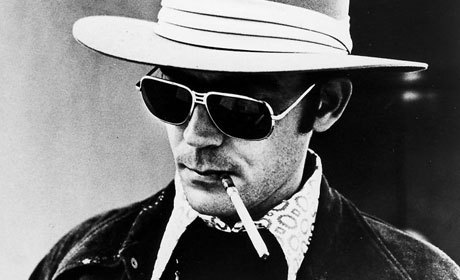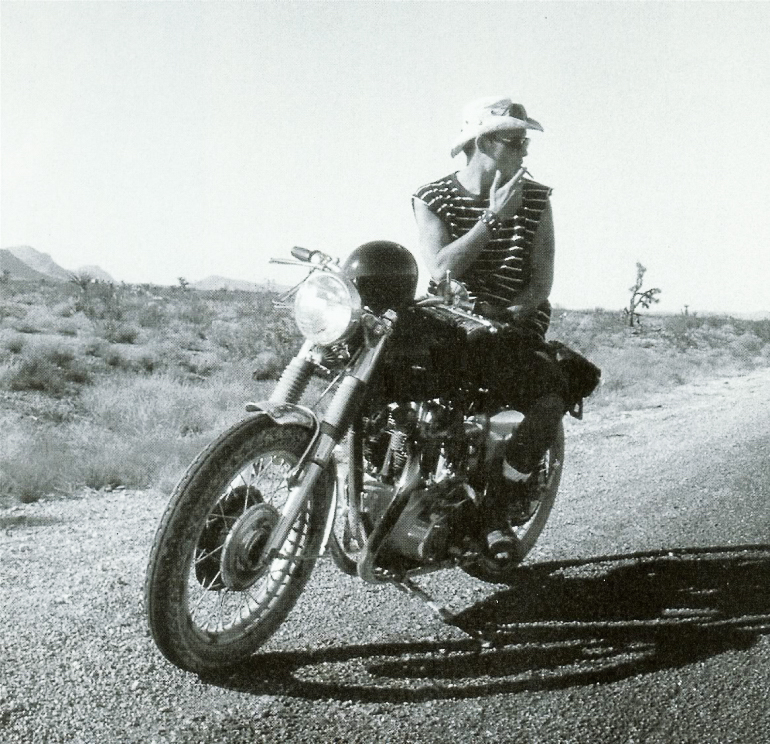NOTES FROM UNDERGROUND
Hope
Links
- Get link
- X
- Other Apps
20 Great Articles and Essays by Hunter S. Thompson and more
Every man is the sum total of his reactions to experience. As your experiences differ and multiply, you become a different man, and hence your perspective changes. This goes on and on. Every reaction is a learning process; every significant experience alters your perspective.In an October 1957 letter to a friend who had recommended he read Ayn Rand’s The Fountainhead, Hunter S. Thompson wrote, “Although I don’t feel that it’s at all necessary to tell you how I feel about the principle of individuality, I know that I’m going to have to spend the rest of my life expressing it one way or another, and I think that I’ll accomplish more by expressing it on the keys of a typewriter than by letting it express itself in sudden outbursts of frustrated violence. . . .”
Thompson completed The Rum Diary, his only novel to date, before he turned twenty-five; bought by Ballantine Books, it finally was published—to glowing reviews—in 1998. In 1967, Thompson published his first nonfiction book, Hell’s Angels, a harsh and incisive firsthand investigation into the infamous motorcycle gang then making the heartland of America nervous.
Fear and Loathing in Las Vegas, which first appeared in Rolling Stone in November 1971, sealed Thompson’s reputation as an outlandish stylist successfully straddling the line between journalism and fiction writing. As the subtitle warns, the book tells of “a savage journey to the heart of the American Dream” in full-tilt gonzo style—Thompson’s hilarious first-person approach—and is accented by British illustrator Ralph Steadman’s appropriate drawings.
His next book, Fear and Loathing: On the Campaign Trail ’72, was a brutally perceptive take on the 1972 Nixon-McGovern presidential campaign. A self-confessed political junkie, Thompson chronicled the 1992 presidential campaign in Better than Sex (1994). Thompson’s other books include The Curse of Lono (1983), a bizarre South Seas tale, and three collections of Gonzo Papers: The Great Shark Hunt (1979), Generation of Swine (1988) and Songs of the Doomed (1990).
In 1997, The Proud Highway: Saga of a Desperate Southern Gentleman, 1955-1967, the first volume of Thompson’s correspondence with everyone from his mother to Lyndon Johnson, was published. The second volume of letters, Fear and Loathing in America: The Brutal Odyssey of an Outlaw Journalist, 1968-1976, has just been released.
https://www.theparisreview.org/interviews/619/the-art-of-journalism-no-1-hunter-s-thompson
The Electric Typewriter
Great articles and essays by the world's best journalists and writers >>>
Misadventure
The Kentucky Derby Is Decadent and Depraved
"I got off the plane around midnight and no one spoke as I crossed the dark runway to the terminal. The air was thick and hot, like wandering into a steam bath..."Doomed Love at the Taco Stand
"Going to Hollywood is a dangerous high-pressure gig for most people, under any circumstances. It is like pumping hot steam into thousands of different-size boilers..."On Politics
Freak Power in the Rockies
"On the Weird Mechanics of Running a Takeover Bid on a Small Town. . . and a Vulgar Argument for Seizing Political Power and Using It like a Gun Ripped Away from a Cop. . . with Jangled Comments on the Uncertain Role of the Head and the Awful Stupor Factor"He Was a Crook
"Richard Nixon is gone now, and I am poorer for it. He was the real thing - a political monster straight out of Grendel..."On Crime
The Motorcycle Gangs
"Ever since World War II, California has been strangely plagued by wild men on motorcycles. They usually travel in groups of ten to thirty, booming along the highways and stopping here are there to get drunk and raise hell..."Strange Rumblings in Aztlan
"Aztlan - the "conquered territories" that came under the yoke of Gringo occupation troops more than 100 years ago, when vendito politicians in Mexico City sold out to the US in order to call off the invasion that Gringo history books refer to as the Mexican American War."The Professional Voice of Law Enforcement
"Weapons are my business. You name it and I know it: guns, bombs, gas, fire, knives and everything else. Damn few people in the world know more about weaponry than I do..."Prisoner of Denver
"The case of Lisl Auman, who first wrote me from prison three years ago, is so rotten and wrong and shameful that I feel dirty just for knowing about it, and so should you..."On American Culture
The Hippies
"The best year to be a hippie was 1965, but then there was not much to write about, because not much was happening in public and most of what was happening in private was illegal..." (Scroll to the bottom for the HST text).Fear and Loathing in las Vegas
"We were somewhere around Barstow on the edge of the desert when the drugs began to take hold..."The Song of the Sausage Creature
"There are some things nobody needs in this world, and a bright-red, hunch-back, warp- speed 900cc cafe racer is one of them..."Fear and Loathing in America
The towers are gone now, reduced to bloody rubble, along with all hopes for Peace in Our Time. Make no mistake about it: We are At War now -- with somebody -- and we will stay At War with that mysterious Enemy for the rest of our lives.Rare Early Articles
Nine hard to find pieces from early in Thompson's career, all scanned in their original layouts. (Click the images to enlarge.)
Books
The Great Shark Hunt
Spanning HST's journalism from National Observer, Rolling Stone and Scanlan's, The Great White Shark Hunt is a stack of golden-age Gonzo.Kingdom of Fear
Journalistic escapades, brushes with the law and political power, as well as his trademark mayhem, HST tells the story of a life on the edge.Hunter S. Thompson: The Final 24 (Full Documentary)
Gonzo journalism was an attitude, an experiment, and a withering critique of hypocrisy and mendacity. It began as an accident, peaked with several works of startling power and originality, and eventually consumed its creator. By that time, however, Gonzo was shorthand for Hunter S. Thompson’s work, signature style, and the most distinctive American voice in the second half of the 20th century. Now, five decades after Rolling Stone published “Fear and Loathing in Las Vegas,” Gonzo journalism is due for a fresh review.
Gonzo’s basic story is quick to tell. In 1970, Thompson queried Warren Hinckle at Scanlan’s Monthly: would he be interested in a piece about the Kentucky Derby? Hinckle paired Thompson with Ralph Steadman, whose grotesque illustrations complemented Thompson’s scathing portrait of Louisville society. “The Kentucky Derby Is Decadent and Depraved” was heralded as a journalistic breakthrough, and Thompson’s friend at the Boston Globe, Bill Cardoso, first applied the term Gonzo to it.
I got off the plane around midnight and no one spoke as I crossed the dark runway to the terminal. The air was thick and hot, like wandering into a steam bath. Inside, people hugged each other and shook hands … big grins and a whoop here and there: “By God! You old bastard! Good to see you, boy! Damn good … and I mean it!”
In the air-conditioned lounge I met a man from Houston who said his name was something or other — “but just call me Jimbo” — and he was here to get it on. “I’m ready for anything, by God! Anything at all. Yeah, what are you drinkin?” I ordered a Margarita with ice, but he wouldn’t hear of it: “Naw, naw … what the hell kind of drink is that for Kentucky Derby time? What’s wrong with you, boy?” He grinned and winked at the bartender. “Goddam, we gotta educate this boy. Get him some good whiskey … ”
Fear and Loathing on the Campaign Trail '72 >>>
A half-century after its original publication, Hunter S. Thompson’s Fear and Loathing on the Campaign Trail ’72 remains a cornerstone of American political journalism and one of the bestselling campaign books of all time. Thompson’s searing account of the battle for the 1972 presidency—from the Democratic primaries to the eventual showdown between George McGovern and Richard Nixon—is infused with the characteristic wit, intensity, and emotional engagement that made Thompson “the flamboyant apostle and avatar of gonzo journalism” (The New York Times). Hilarious, terrifying, insightful, and compulsively readable, Fear and Loathing on the Campaign Trail ’72 is an epic political adventure that captures the feel of the American democratic process better than any other book ever written—and that is just as relevant to the many ills and issues roiling the nation today. As Johnny Knoxville writes in his foreword to this 50th anniversary edition: “Hunter predicted it all.”
- Director:
- Writer:
- Release Date (Theaters):Limited
Hunter S. Thompson's Daily Routine
3:05 Chivas Regal with the morning papers, Dunhills
3:45 cocaine
3:50 another glass of Chivas, Dunhill
4:05 first cup of coffee, Dunhill
4:15 cocaine
4:16 orange juice, Dunhill
4:30 cocaine
4:54 cocaine
5:05 cocaine
5:11 coffee, Dunhills
5:30 more ice in the Chivas
5:45 cocaine, etc., etc.
6:00 grass to take the edge off the day
7:05 Woody Creek Tavern for lunch-Heineken, two margaritas, coleslaw, a taco salad, a double order of fried onion rings, carrot cake, ice cream, a bean fritter, Dunhills, another Heineken, cocaine, and for the ride home, a snow cone (a glass of shredded ice over which is poured three or four jiggers of Chivas)
9:00 starts snorting cocaine seriously
10:00 drops acid
11:00 Chartreuse, cocaine, grass
11:30 cocaine, etc, etc.
12:00 midnight, Hunter S. Thompson is ready to write
12:05-6:00 a.m. Chartreuse, cocaine, grass, Chivas, coffee, Heineken, clove cigarettes, grapefruit, Dunhills, orange juice, gin, continuous pornographic movies.
6:00 the hot tub-champagne, Dove Bars, fettuccine Alfredo
8:00 Halcyon
8:20 sleep
Hunter S. Thompson meets a Hell's Angel, 1967 | CBC
Hunter S. Thompson Omnibus 1978
Hunter S. Thompson's America
Jack Kerouac influenced me quite a bit as a writer . . . in the Arab sense that the enemy of my enemy was my friend. Kerouac taught me that you could get away with writing about drugs and get published […] I wasn’t trying to write like him, but I could see that I could get published like him and make the breakthrough, break through the Eastern establishment ice.
When Ginsberg died in 1997, Thompson wrote a bizarre epitaph, which he gave to Johnny Depp to read at the memorial service. Written like a news report, the unconventional eulogy refers to Ginsberg as “a dangerous bull-fruit with the brain of an open sore and the conscience of a virus.” He goes on:
He was a monster. He was crazy and queer and small. He was born wrong and he knew it. He was smart but utterly unemployable. The first time I met him in New York he told me that even people who loved him believed he should commit suicide because things would never get better for him. And his poetry professor at Columbia was advising him to get a pre-frontal lobotomy because his brain was getting in his way. “Don’t worry,” I said, “so is mine. I’m getting the same advice. Maybe we should join forces. Hell, if we’re this crazy and dangerous, I think we might have some fun . . .” I spoke to Allen two days before he died. He was gracious as ever. He said he’d welcome the Grim Reaper because he knew he could get into his pants
HUNTER S. THOMPSON AND THE BEATS >>>





















.jpg)